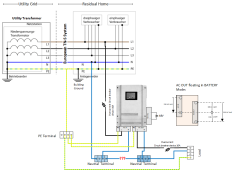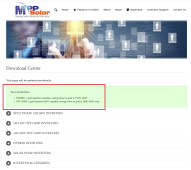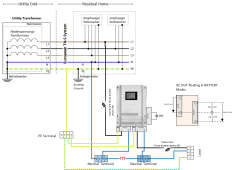EliteSolar
New Member
- Joined
- Sep 22, 2020
- Messages
- 90
Hi All!
There is a problem with the N/G bond and my setup .
I live in Europe, 230V and the N/G bond is made outside of my house.
So I have 3.1kw panels with a 3.6kw hybrid AIO ( EASUN SMG II ) that can run batteryless but also "blend/mix" power with the Grid.
I don't use batteries.
My model never bonds N/G and relies that the bond is made with my grid .
So when grid is off ( AC IN ) my inverter powers the loads just with solar panels directly, but then it goes into "battery mode" and loses the N/G bond. I tested the volt between neutral and ground and it was 160V and my ground tester says GROUND NOT OK. Of course everything works fine when there is AC IN because the AC IN is already N/G bonded and that carries through the inverter "Line Mode".
I understand the solution is to get the grounding box to connect to the dry connects and enable the option "When in battery mode , trigger the grounding box to make the N/G bond"
But I have some questions :
1) Since I will always have AC IN connected , I understand when the grid goes down , most of the time only L is cut and not N/G , does this mean the bond continues to work ? Or does the inverter senses no volt between L and N and cuts the connection and works in battery mode ? I guess the 2nd ?
2) Since there is hardly any grid disconnects and I plan to always use the AC IN , I understand the problem will be like 5 hours per year . If there is no grounding those hours , and it is daylight the solar panels will directly feed the inverter AC OUTPUT in "battery mode" ( without battery ). Does the RCD somehow protects me during those hours ? I've read various reports that the RCD would protect me and others that grounding is needed for RCD to work. Others say that for some functions the RCD protects you but for others it needs ground ? I still don't like the idea that the will be no ground for those 5 hours but if the RCD protects me, then I guess it's not that bad ?
3) People that have asked MPP and EASUN and I have read that twice in the forums , that they suggest you bind AC IN's Neutral and AC OUTPUT Neutral ? Is this correct ?! Is this really a solution for the N/G bond problem ? Doesn't sometimes the grid cut the N too ? Is this safe ? Or have I misunderstood something ?
4) Is there anyway I can just switch off the inverter when the grid is down ? I don't care if my system doesn't work when the grid is off because that hardly happens ( maybe 5 hours per year , some years ) . Is there any priority mode or any setting that would do that ? For me that would be my best solution because I don't have to worry about the N/G problem and if the grounding box is working correctly , plus I don't have to buy the grounding box. If there is not setting to do that , is there any DIN rail switch that will disable power if no grounding is detected maybe ?
5) If there is no workaround, I can always buy the grounding box , no problem, its like 50euro . I still think the inverter is good value since I only paid 430e , so still less than 500e for an AIO 3.6kw that works batteryless and can blend/mix power from grid.
I was just wondering how other people have tacked this problem in a similar scenario, it would be the same running it with batteries or batteryless , they would go into the same "battery mode" when there is no AC IN ( grid ) .
Thanks!
There is a problem with the N/G bond and my setup .
I live in Europe, 230V and the N/G bond is made outside of my house.
So I have 3.1kw panels with a 3.6kw hybrid AIO ( EASUN SMG II ) that can run batteryless but also "blend/mix" power with the Grid.
I don't use batteries.
My model never bonds N/G and relies that the bond is made with my grid .
So when grid is off ( AC IN ) my inverter powers the loads just with solar panels directly, but then it goes into "battery mode" and loses the N/G bond. I tested the volt between neutral and ground and it was 160V and my ground tester says GROUND NOT OK. Of course everything works fine when there is AC IN because the AC IN is already N/G bonded and that carries through the inverter "Line Mode".
I understand the solution is to get the grounding box to connect to the dry connects and enable the option "When in battery mode , trigger the grounding box to make the N/G bond"
But I have some questions :
1) Since I will always have AC IN connected , I understand when the grid goes down , most of the time only L is cut and not N/G , does this mean the bond continues to work ? Or does the inverter senses no volt between L and N and cuts the connection and works in battery mode ? I guess the 2nd ?
2) Since there is hardly any grid disconnects and I plan to always use the AC IN , I understand the problem will be like 5 hours per year . If there is no grounding those hours , and it is daylight the solar panels will directly feed the inverter AC OUTPUT in "battery mode" ( without battery ). Does the RCD somehow protects me during those hours ? I've read various reports that the RCD would protect me and others that grounding is needed for RCD to work. Others say that for some functions the RCD protects you but for others it needs ground ? I still don't like the idea that the will be no ground for those 5 hours but if the RCD protects me, then I guess it's not that bad ?
3) People that have asked MPP and EASUN and I have read that twice in the forums , that they suggest you bind AC IN's Neutral and AC OUTPUT Neutral ? Is this correct ?! Is this really a solution for the N/G bond problem ? Doesn't sometimes the grid cut the N too ? Is this safe ? Or have I misunderstood something ?
4) Is there anyway I can just switch off the inverter when the grid is down ? I don't care if my system doesn't work when the grid is off because that hardly happens ( maybe 5 hours per year , some years ) . Is there any priority mode or any setting that would do that ? For me that would be my best solution because I don't have to worry about the N/G problem and if the grounding box is working correctly , plus I don't have to buy the grounding box. If there is not setting to do that , is there any DIN rail switch that will disable power if no grounding is detected maybe ?
5) If there is no workaround, I can always buy the grounding box , no problem, its like 50euro . I still think the inverter is good value since I only paid 430e , so still less than 500e for an AIO 3.6kw that works batteryless and can blend/mix power from grid.
I was just wondering how other people have tacked this problem in a similar scenario, it would be the same running it with batteries or batteryless , they would go into the same "battery mode" when there is no AC IN ( grid ) .
Thanks!







